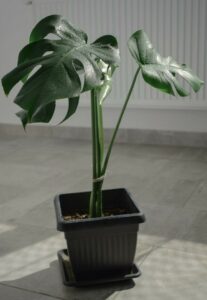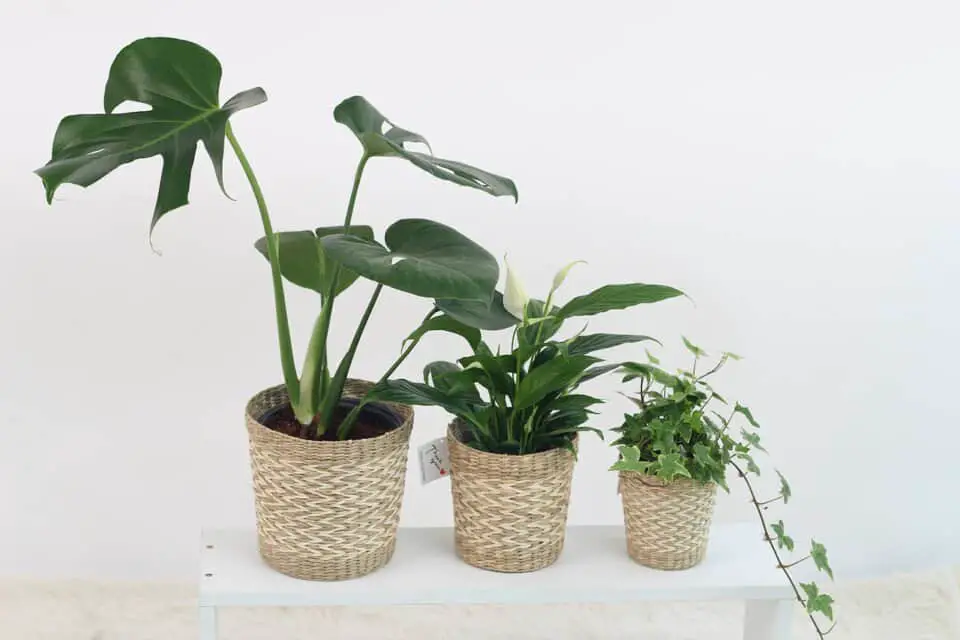Some links in the post are affiliate links and I get a commission from purchases made through some links found in the post.
Propagation involves reproducing plants and if you are wondering how to propagate your monstera plant, then you have come to the right place. Propagation is important to ensure that the growth of your monstera is controlled.
Propagating a monstera plant can be done by cutting, layering, or by using seeds.
The propagation method you choose for your plant depends on preference, but you have to ensure that every procedure is followed precisely.
Going further into this guide, we will discuss all the information you need to know about propagating a monstera plant as well as how to properly carry out this task.
Why Propagate a Monstera?
 A monstera plant is a unique plant known for its infamous holes that makes it aesthetically pleasing in any indoor space.
A monstera plant is a unique plant known for its infamous holes that makes it aesthetically pleasing in any indoor space.
At a certain stage of your monstera journey, the growth of this plant will be rapid and to an extent uncontrollable. In a situation where this uncontrollable growth occurs, propagation is one way to manage the growth.
You also get rewarded for propagating and this reward comes by having another monstera plant in your possession.
This is an easier way to acquire a copy of your favorite plant without spending too much, another upside is that it reduces your garden carbon footprint.
Where on a Monstera Should you Propagate?
The part of a monstera plant that is very vital for propagation is the node as the whole process will be useless without this part.
To identify the node on your monstera plant, you have to keep an eye on where the twig, bud, and leaves originate from. it is best to check beneath a stem or branch to locate a node.
There is another portion of a plant called the internode, this is the portion between two nodes.
To get a node when cutting your monstera plant, target the stem on the internode and be cautious not to cut out a leaf because this part does not have a node.
Can a Monstera be Propagated Without a Node?
No, your monstera cannot be propagated without a node.
The node can be identified as the area where a bump appears to be visible and because this bump is in the area where other parts of the plant originate from, you can observe some growth when you plant the node of your monstera.
What are the Stages of Propagation of a Monstera?
The stages of propagating a monstera plant cover all the necessary procedures that should come before the main propagation of this plant.
Unrooted Cutting
Unrooted cutting involves harvesting a growing part of a plant and caring for it until the propagation period.
This type of cutting has no roots, although growing aerial roots may be present as these roots originate from the nodes, this type of root cannot sustain plant growth.
If care is not given to an unrooted cutting, it will gradually die. For an unrooted cutting from a monstera plant you will need to supply it with an external source of water and some light from a shaded area, this condition will help this monstera plant to photosynthesize and grow healthy roots that can sustain the plant.
Rooted Cutting
A cutting with fully grown roots is considered to be a rooted cutting. The growth of a mature root starts with single, small, and hairy white roots that emerge from the stem (aerial roots).
When this single aerial root absorbs all the water, light, and nutrient it needs, feeder roots will begin to emerge from it.
Feeder roots are small roots that are developed from woody roots and grow outside at the surface of the soil.
These roots gain access to nutrients, water, and oxygen from the surface where these elements are abundant to sustain the growth of your plant.
Established Rooting
An established rooting is formed when the main woody root and the feeders are developed enough to be transferred to a new environment.
The fully grown root is longer than it initially was, but you have to brace yourself during the transfer process as some roots die at this stage. This can be a result of an inability to adapt to a new environment.
Getting a Brand New Plant
If the transfer of your cutting to soil is successful, then you will begin to observe the growth of a new monstera plant. At this stage, you should give your monstera plant the required amount of water, light, and nutrient.
According to Purdue Consumer Horticulture, a plant grown from a cutting will mature faster and flower earlier, these monstera grown through cutting will also inherit the special characteristics of the parent plant.
How Long Does it Take to Propagate a Monstera?
Typically, it takes some months to propagate a healthy monstera plant. Although, this period depends on one important factor and that is the quality of the cutting. Below are the types of cutting that can be applied to a monstera plant.
Top Cutting
 This is the most used kind of cutting as it is straightforward.
This is the most used kind of cutting as it is straightforward.
All you need to do is cut your stem (separate the top from the bottom) on the internode removing this stem requires you to remove the terminal bud as well. The terminal bud is the bud positioned at the top of a stem.
This method is widely used because the cut area quickly heals and the leaves that grow out of this cut region still mature the normal way. In this type of cutting, the leaves of the plant remain.
Mid Cutting
As the name implies, this cutting is made from the middle of the stem. Once the top cutting is off, additional cuttings can be made from the midpoint of the stem of this plant.
For a mid-cut, growth will start all over again from the node auxiliary bud.
Stem Cutting
Stem cutting involves a process where the stem is detached from its bottom. This cutting is similar to the top cutting but it works without leaves, it only contains nodes.
The absence of leaves does not determine the ability of your monstera plant to be propagated, but it leads to slow growth as leaves are absent for photosynthesis.
Now back to the main question, how long does it take to propagate a monstera?
For a top cutting with aerial roots involved, this process should take about 1½ months, for a mid-cut with an aerial root system propagation will take about 3 months and for stem cutting with an aerial root system, the propagation should take about 4 months.
How to Make the Cut
We have explained the basics of cutting and all the necessary knowledge involved in this process, this knowledge combined with a guide on how to perform this task should help you make a smooth cut.
Step One: Mark a Spot
Locate a node and then an auxiliary bud that lies close to the node. The cut will be made at the location just above the node and an auxiliary bud should be included in the cut.
Step Two: Make the Cut
Using a pair of clean and sharp shears, cut at about an angle of 30 degrees and ensure that this cut comes out smooth without causing any severe damage to the parent plant.
The section below covers the basics of propagation and what you need to do to keep your cutting healthy.
Basics of Propagation
After the cutting is done, it is vulnerable to a lot of factors that can cause it to die.
This is because it has been separated from its parent plant and is deprived of the water and nutrients it needs to grow, here are some steps you can take to ensure that your cutting remains healthy.
Reducing Water Loss
To reduce water loss after cutting, you should water your plant before the day of cutting and this process should be done before midday as the heat may dry up some of the water contents.
Place the cutting in water immediately, and for stem cutting, it is advised that you pluck out some leaves to prevent them from using up the water.
Preventing Attacks from Diseases
Your cutting should be from a healthy parent plant without pests and diseases on it.
Since your cutting is exposed and prone to diseases, you should use clean tools for this process and if you are clueless about how to clean your tools accurately, you can use bleach as a cleaning agent.
What Propagation Method are you Going to Use?
 There are three major ways to propagate your monstera plant and this is by regular cutting, air layering, and by the use of seeds.
There are three major ways to propagate your monstera plant and this is by regular cutting, air layering, and by the use of seeds.
For the propagation to be successful, your monstera needs to grow a strong root and you need to prevent it from rotting.
Inserting your cut in water will help it develop its aerial root necessary for soil support, and to keep this plant from rotting, the cut end of the stem should be kept away from the propagation area to keep the cut dry.
It is important to note that nutrients should only be added to the water used to propagate your monstera when the roots start to develop, this is because the absorption of nutrients cannot happen without the roots present.
1) Air Layering
Air layering is a method of propagation using stems that are still attached to their parent plant. Below is a quick guide on how to propagate your monstera plant using this method.
- Be sure that your monstera plant is healthy before propagation then locates a node and make a cut through it that points towards the tip of the shoots. (the cut should be about 2.5 cm). Do not cut off the stem completely.
- Apply a decent amount of moist sphagnum moss then secure this area with plastic wrap. Take off the plastic wrap and reapply the moist moss if the previous one is dried off. According to RHS the thickness of the moss applied to the cut should be 3 to 4 inches.
- Leave this plastic wrap in place for about nine months then check for any sign of rooting in the stem. When strong roots can be observed growing out of the stem, remove the plastic wrap securing the moss and cut the stem off. At this point, you can now situate your monstera in a pot with soil. Care for your monstera appropriately to observe growth.
In some cases, moss can be used in place of soil as it retains the humidity required for this plant. The only problem is that using moss can be complicated and if not done right, your monstera may wilt.
Pros of Air Layering
- Reduced rate of rotting
- Air layering does not affect the parent plant
- It brings about a rapid growth of strong root
Cons of Air Layering your Monstera
- Ineffective for top cuttings without aerial roots
- This process is labor-intensive and time-consuming
2) Propagation by Water
This is one of the simplest ways of propagating a monstera plant as it involves placing your cutting in a jar of clean water. The steps below cover how to propagate a monstera using this process in a more detailed manner.
- Locate the node on your monstera plant and snip the stem correctly using clean shears
- If the leaves on the stem are more than 3, cut out these additional leaves. This is because a stem with many leaves will consume more energy than a stem with 2 or 3 leaves.
- Get a clean jar and fill it halfway with clean water (at room temperature). Make sure that the water being used is not chlorinated.
- Position your stem to be in an upright position. This is best done by using a tall jar.
- Change the water in the jar after 2 days for proper growth of the roots
- Transfer the monstera plant to the soil at this stage. This will help further its growth.
It is recommended that you carry out this propagation during spring and summer, and to prevent the stem from rotting, keep the cuts out of water.
Pros of Water Propagation
- Root growth can be monitored easily with the help of a transparent jar
- There is a rapid growth of roots using this method
- Nutrients are not necessary for the growth of roots
Cons of Water Propagation
- It is difficult to keep the stem cut out of the water making your monstera prone to rotting
- Plants that use this method of propagation find it difficult to transition when transferred to soil
- Dissolved oxygen in the water may not be enough for a monstera plant. Although this problem can be fixed by using fish tank air stones as they increase the oxygen level of the water.
3) Propagation by Soil

This is similar to the propagating with water, the only difference is that the cutting does not sit in water before getting into the soil.
Some people may find it more reasonable to skip the water process and jump straight to propagation in soil, while this is also an effective propagation method, it takes longer to achieve and the cutting requires more care.
You will need to supply an adequate amount of water, sunlight, and nutrient to your growing monstera for it to thrive.
Pros of Soil Propagation
- No transfer is required in this process
Cons of Soil Propagation
- Takes a longer time to achieve
- Demands more care
4) Propagation by Seed
If you have the seeds of this plant from a mature monstera, propagation can be done directly using this method. When using seeds, you have to plant them immediately as they don’t have a long shelf life.
All you need to do is soak these seeds in water for about 12 to 24 hours and then after it swells a little, plant them in moist soil.
The soil should be kept moist at all times and it should be allowed to receive mild indirect sunlight. After2 to 3 weeks, you should see your monstera plant come out from the soil.
Will the Propagated Area Grow Back?
If you are wondering if the area cuts are made from will grow back then no, this propagated area will not grow back.
Instead, a different kind of growth occurs. The new growth starts in the node or bud underneath the cut portion.
The good thing about this new growth is that it happens rapidly, so if you are worried about your monstera not developing new stems after propagation, this should answer your question and you should be able to propagate without hesitation.
Common Mistakes Made when Propagating a Monstera
Direct Sunlight
Monstera plants are shade-loving species that love to receive indirect light. Intense light on your growing monstera can cause sunburn which is detrimental to its health.
To avoid direct sunlight, you will need to keep your monstera plant a few inches away from your window no matter how lovely it looks under the sun’s rays.
Overwatering
It is already established that your monstera needs water to grow especially in the early stage of this propagation.
However, not all propagation methods will require you to make a full cutting and for monsteras in soil, the amount of water given to this plant should be regulated.
A good suggestion is to keep your monstera moist most of the time and this can be done by misting or maintaining the humidity level in its environment.
Blunt Shears
Sharp shears are always recommended because they allow you to make quick and smooth cutting which is important to the health of the parent plant.
Furthermore, blunt shears may be infected and can pose a risk of spreading this infection with your cutting.
Final Thoughts
 Propagation scares a lot of monstera owners because of the fear of harming the plant as a whole.
Propagation scares a lot of monstera owners because of the fear of harming the plant as a whole.
Propagation can be easy and an effective method to gain more of your favorite plant, but all you have to do is follow the instructions provided carefully.
This article contains all the guidance you need to propagate your monstera plant and in no time your indoor space will be filled with this Swiss-cheese plant.


